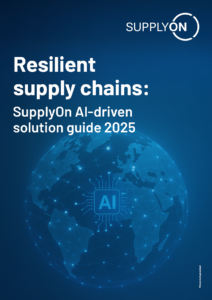True Software as a Service (SaaS) vs. ASP: What are the differences and why does true SaaS provide benefits in an SCM environment?
![]()
Over the past few years many companies have shown a growing interest in applying the software-as-a-service concept to a wide range of processes. This can be attributed to the many benefits provided by SaaS compared with conventional software licensing models.
- For example, neither software licenses nor hardware have to be purchased, and usage is generally governed by a service contract agreement for a specified time period. The service is billed at regular intervals, based on different criteria (e.g., per user or per transaction). Thus high up-front investments are not required, and this service provides a considerably higher degree of flexibility in matching usage to ever-changing requirements.
- Usage is Internet-based, meaning only a web browser and an Internet connection are required. There is no need to launch a complicated and expensive IT project. The provider also takes care of release management and software update testing, as well as secure, high-availability operation.
- Business enterprises are no longer obliged to perform cost-intensive and rather complex tasks, allowing them to concentrate on their core business and on the processes that distinguish them from their competitors. Providers also usually offer support for SaaS, either as a standard contract element or as an option.
Of course, this list of benefits could also be used to describe the widespread application service provision (ASP) model. What are the differences between SaaS and ASP, and why is a true SaaS model more sustainable, especially in a supply chain management (SCM) context?
What is ASP?
The ASP model involves an external provider running the software and handling release management on behalf of the enterprise customer. In the ASP approach it is important that enterprise customers are given their own separate software instance. This entails quite a lot of release management work on the part of ASP providers. For example, they must test various software installations at various customer sites with every new software release.
 ASP also has other significant implications in a supply chain management environment, where enterprises do business with a large number of suppliers, and where many suppliers deliver to the same customers. From the suppliers’ perspective, all customer solutions are separated. And due to separated data storage, suppliers have no direct way of aggregating data to increase the efficiency of their own operations.
ASP also has other significant implications in a supply chain management environment, where enterprises do business with a large number of suppliers, and where many suppliers deliver to the same customers. From the suppliers’ perspective, all customer solutions are separated. And due to separated data storage, suppliers have no direct way of aggregating data to increase the efficiency of their own operations.
What’s more, having clearly separated software instances for each enterprise customer means that customers usually make very specific demands that result in more work and expense for the supplier. Businesses that prefer the ASP approach want to have their specific requirements satisfied. These can include GUI designs in corporate colors, the use of corporate logos and specified processes and data formats.
Industry-wide standardization is simply not possible with this approach. As far as suppliers are concerned, the ASP model means that there is no difference between solutions operated internally by customers themselves or those operated by an external specialist. In all cases the model involves different, specific customer solutions that have to be fully understood, operated and managed.
Some solution providers try to disguise their ASP offering by telling customers they are getting SaaS – these providers merely set up a “log-in user interface” for suppliers, enabling them to access the various customer instances. While this saves time and work when managing a large number of user IDs and passwords, it is not really very efficient. In the case of customer A, for example, you still find software instance A in version A, configuration A and data storage mode A. The same applies to customer B, C, D, etc.
What is SaaS and what benefits does this model deliver in an SCM environment?
 An authentic SaaS approach is essentially characterized by the fact that all users work with exactly the same software instance, which can be accessed via the Internet. In terms of supply chain collaboration, this provides a wide range of benefits for both suppliers and their enterprise customers.
An authentic SaaS approach is essentially characterized by the fact that all users work with exactly the same software instance, which can be accessed via the Internet. In terms of supply chain collaboration, this provides a wide range of benefits for both suppliers and their enterprise customers.
For all parties involved: Establishment of genuine industry standards and communities
The SaaS model enables the establishment of consistent standards in every branch of industry because each business enterprise uses the same software. To a certain extent this software can be configured to satisfy specific company requirements, but the basic software functionality and adaptability are identical for all companies. Thus industry-wide standards can be defined in order to increase efficiency to the benefit of all companies involved.
For suppliers: One software solution for managing diverse customer relationships
Suppliers need just one single log-in to access data for a large number of diverse customers. They can also collaborate with several customers using the exact same software instance. Since the software pools all customer data in a standardized format, suppliers can efficiently adjust their view of customer data to match their own processes and areas of responsibility, using filters and GUI modifications. They can also share this information with colleagues using a uniform role or function model. Since exactly the same software is used for a large number of customers, the additional work of repeatedly adapting to many different customer versions is no longer necessary. Thus suppliers save quite a lot of time and money.
For customers: Higher degree of acceptance among suppliers results in a better business case
Business enterprises benefit from the fact that their suppliers already handle specific processes with other customers using the same software. In other words, the company does not have to start the supplier rollout process from scratch – a certain proportion of its suppliers are already familiar with and use the same software. These suppliers can be activated very quickly to serve new business enterprises. This has a positive impact on onboarding periods, benefit generation and thus on business cases.
SupplyOn’s experience in launching a large number of global rollout projects shows that suppliers will adopt a shared solution for a large number of customers much more readily than a company-specific approach.
Your own requirements already specify which is the right model for you
Ultimately, however, it is not a question of whether the ASP model or the SaaS approach is better. The requirements and perceptions of a business enterprise are usually good indicators of the model that is likely to be chosen.
If you believe that suppliers need to see your company logo and your corporate colors when they log in, and that your company-specific processes need to be mapped in the solution, then the SaaS model is not the right option for you. In a true SaaS model, where many companies and customers are doing business with each other, there can be only one single solution available to all. For example, which logo should be displayed to a supplier who not only collaborates with you, but also with one of your competitors?
Specifications of that kind can only be realized using a dedicated software solution based on an ASP approach. At Salesforce.com, for example, there is only one standard for the user interface. While reports and GUIs can be configured, they are identical for all customers and users, depending on the license used. No company has the option of implementing customized CIs.
On the other hand, if you think standardization is more important than individualization, and your business enterprise, as a member of an industry community, favors progress in supplier rollout in order to gain benefits quickly, then the SaaS model is the better option for you.
How can ASP and SaaS be identified in practical terms?
Be sure to ask solution providers if their approach is based on a single instance, multitenant (shared) platform. If you don’t get a straight answer, that’s a strong indication that the solution is based on an ASP model.
Ask the providers if all data is aggregated, and if suppliers doing business with several customers require just one single display. If the answer is no, you can assume that the offer is an ASP solution.




